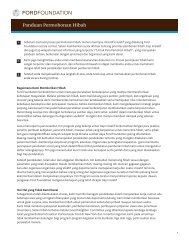Globalization, Health Sector Reform, Gender and ... - Ford Foundation
Globalization, Health Sector Reform, Gender and ... - Ford Foundation
Globalization, Health Sector Reform, Gender and ... - Ford Foundation
- No tags were found...
Create successful ePaper yourself
Turn your PDF publications into a flip-book with our unique Google optimized e-Paper software.
undermine the reforms themselves. Conditions of health provisionin many low-income countries have deteriorated due partlyto lack of financial resources to repair deteriorating facilities <strong>and</strong>equipment. This situation has been exacerbated by the demoralizationof public-sector workers who have seen their real incomesfall dramatically since the early 1980s.Analyses of thegender dimensions ofStructural AdjustmentPrograms (SAPs) haveconcluded that genderdifferences in impactare systematic <strong>and</strong> notincidental or ad hoc.The gender dimensions of Structural Adjustment Programs (SAPs),including the associated breakdown of social provision, have beenanalyzed in some depth. One of the central conclusions of thiswork is that gender differences in impact are systematic <strong>and</strong> notincidental or ad hoc (Commonwealth Secretariat, 1989; Elson, 1991;Afshar <strong>and</strong> Dennis, 1992). There is still insufficient evidence-basedanalysis linking SAPs specifically to particular outcomes forwomen’s health <strong>and</strong> well-being, since, as Hilary St<strong>and</strong>ing (1999)points out, much of the analysis is derived from first principles.Nevertheless, testaments to the increased violence experiencedby women in this period are symptomatic of the ways in whichthe burden of adjustment has been felt most acutely by women.There is even less evidence-based analysis of the gender dimensionsof globalization. As yet, there has been little multi-countryanalysis of the linkages among globalization, health sector reform,<strong>and</strong> women’s health <strong>and</strong> reproductive rights. However, a few ongoingstudies may provide helpful insights although their resultsgenerally have not been made available. One of these studies isfunded by the Canadian organization, the International DevelopmentResearch Centre (IDRC). This multi-country investigationattempts to draw linkages among macroeconomic reforms, sectorreform <strong>and</strong> health. However, the gender analysis in the researchproposals seems weak, so it is not yet clear what sort of resultsthis study will produce (IDRC, 1998).Medac, a UK-based organization, is currently managing a largestudy of the impact of health sector reform on health in a numberof developing countries. Again, the gender analysis in this studyis not strong. A more promising prospect is the work proposed bythe Center for <strong>Health</strong> <strong>and</strong> <strong>Gender</strong> Equity (CHANGE) in the UnitedStates (see Appendix 1). Building on the work summarized in the1998 CHANGE <strong>and</strong> Population Council Report, CHANGE isabout to begin a multi-country study (India, Kenya, Mexico, Zimbabwe<strong>and</strong> either Ug<strong>and</strong>a or Tanzania) which looks specificallyat the effects of health sector reform on reproductive health outcomes.This project will also incorporate support for advocacy tostrengthen women’s reproductive rights <strong>and</strong> health.12
















